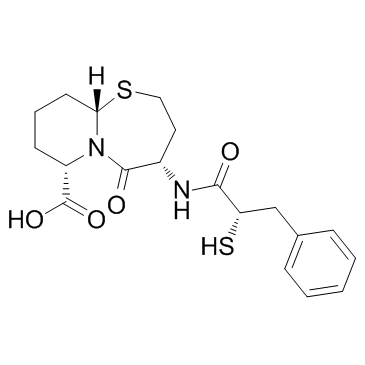| Description |
Omapatrilat is a dual inhibitor of the metalloproteases ACE and NEP with Ki values of 0.64 and 0.45 nM, respectively.
|
| Related Catalog |
|
| Target |
Ki: 0.45 nM (NEP), 0.64 nM (ACE)[1];IC50: 8 nM (NEP), 5 nM (ACE)[2]
|
| In Vitro |
Omapatrilat exhibits high potency for NEP, NEP2 and ACE, moderate strong activity against APP, but low activity against ECE1 (Ki=0.45, 25, 0.64, 250 nM) [1]. In vitro autoradiography using the specific NEP inhibitor radioligand 125I-RB104 and the specific ACE inhibitor radioligand 125I-MK351A show omapatril at (10 mg/kg) causes rapid and potent inhibition of renal NEP and ACE, respectively, for 24 h[4].
|
| In Vivo |
Omapatrilat demonstrates excellent blood pressure lowering in a variety of animal models characterized by various levels of plasma renin activity and significantly potentiates urinary sodium, ANP, and cGMP excretion in a cynomolgus monkey assay. Omapatrilat decreases mean arterial pressure (MAP) approximately 40 mmHg below baseline from 10 to 24 h. Oral administration of omapatrilat at 100 μM/kg once daily results in a 38 mmHg decrease in systolic blood pressure at day three as compared to vehicle [2]. Omapatrilat is widely used in experimental protocols related to hypertension and heart failure. Chronic oral administration of omapatrilat reduces aortic leakiness and atheroma formation with enhanced endothelial independent vasorelaxation to ANP[3]. Omapatrilat causes significant inhibition of plasma ACE and increased plasma renin activity in rats[4].
|
| Kinase Assay |
Omapatrilat is dissolved in 100% DMSO at 10 mM and diluted to 1% DMSO. NEP, NEP2, ACE and APP assays are performed at pH 7.4. The reaction buffer for NEP and NEP2 contained 50 mM HEPES, 140 mM NaCl, 10 mM KCl, 0.01% BSA. The buffer for ACE contained 100 mM Tris-HCl, 50 mM NaCl, 10 μM ZnCl2, and the buffer for APP contained 100 mM HEPES and 0.01% BSA. Assays are performed in 100 μL volume in black 96-well round-bottom plates at room temperature. Reactions are continuously monitored with excitation and emission wavelengths appropriate for each respective substrate. Enzyme velocity is determined from the linear part of the reaction[1].
|
| Animal Admin |
Rats: Sprague Dawley rats are weighed and then gavaged with vehicle (5% arabic gum) or omapatrilat (0.1, 1, 10 mg/kg) (n 5 6 rats/group). Rats are killed by decapitation at 1 h after gavage. Trunk blood is collected into prechilled tubes containing EDTA/aprotinin for the measurement of PRA and into prechilled heparin tubes for the measurement ofplasma ACE[4]. Rabbits: Omapatrilat is dissolved in drinking water. Rabbits are divided into 2 groups with 1% cholesterol diet, placebo-treated group and omapatrilat-treated group, and administrated (12 mg/Kg/day omapatrilat) once daily for 8 weeks. To demonstrate the acute effect of omapatrilat, urine is collected after omapatrilat or placebo administration for 24 hours at day 1, and urine volume, cGMP and ANP levels are assessed[3].
|
| References |
[1]. Fryer RM, et al. Effect of bradykinin metabolism inhibitors on evoked hypotension in rats: rank efficacy ofenzymes associated with bradykinin-mediated angioedema.Br J Pharmacol. 2008 Mar;153(5):947-55. [2]. Robl JA, et al. Dual metalloprotease inhibitors: mercaptoacetyl-based fused heterocyclic dipeptide mimetics asinhibitors of angiotensin-converting enzyme and neutral endopeptidase. J Med Chem. 1997 May 23;40(11):1570-7. [3]. Ichiki T, et al. Endothelial permeability in vitro and in vivo: protective actions of ANP and omapatrilat in experimental atherosclerosis. Peptides. 2013 Oct;48:21-6. [4]. Burrell LM, et al. Antihypertensive and antihypertrophic effects of omapatrilat in SHR. Am J Hypertens. 2000 Oct;13(10):1110-6.
|


